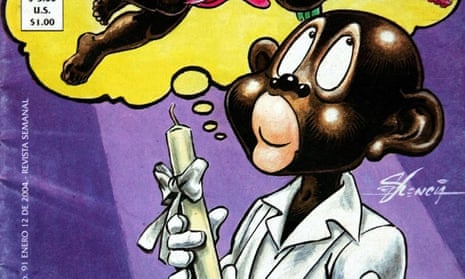Latin America’s enduring fondness for grotesque racist caricatures has returned to the spotlight with the political rise of Guatemalan performer Jimmy Morales.
Morales, currently the frontrunner in the country’s presidential election, was until recently best known as a comedian who performed in blackface portraying a hapless character called “Black Pitaya”, or Black Dragonfruit. Morales no longer plays the character, which he has defended as a harmless joke enjoyed by Guatemalans of all ethnicities. But his image is still used in the country to sell hair products and soap.
Racial caricatures have been used as brands across the region. In Colombia, Mimo’s ice cream flavours were depicted by race: a black man for chocolate, a white girl for vanilla.
Peru perhaps has some of the continent’s most racist characters. Negro Mama is a popular blackface television personality who wears a prosthetic nose, lips and black hairy gloves on his hands. His motto is: “I might be a blacky, but I have my little brain” (Podré ser negrito, pero tengo mi cerebrito).
The character, loathed by the Afro-Peruvian community, is associated with drug trafficking, sexually transmitted diseases and violence. But the popularity of the racist Negro Mama personality remains.

Offensive blackface skits also remain common in Brazil. The program Zorra Total of the Globo TV network featured a male white actor playing a toothless, dirty, ugly, lazy and stupid black beggar woman who constantly humiliates her daughter.
And for the children there is the racist Mexican comic book character Memín Pinguín, who first appeared in 1943. He is a little black boy with the face of a monkey who is slightly exotic, charming and sympathetic, but also inferior and in constant need of discipline and education. Memín was initially depicted as a “pickaninny”, though Mexican authorities insist his character has done much to oppose racism in recent years.

In 2005, Mexico’s government provoked outrage with the release of five postage stamps depicting the character, just weeks after then-president Vicente Fox riled many by saying that Mexican migrants to the US take jobs that “not even blacks” want
Omar Ali, associate professor of Comparative African Diaspora History at the University of North Carolina, said: “In some ways Latin America is 25 or 30 years behind the US and England in terms of awareness of racism and the Africa diaspora. There hasn’t been a Black cultural revolution.”
